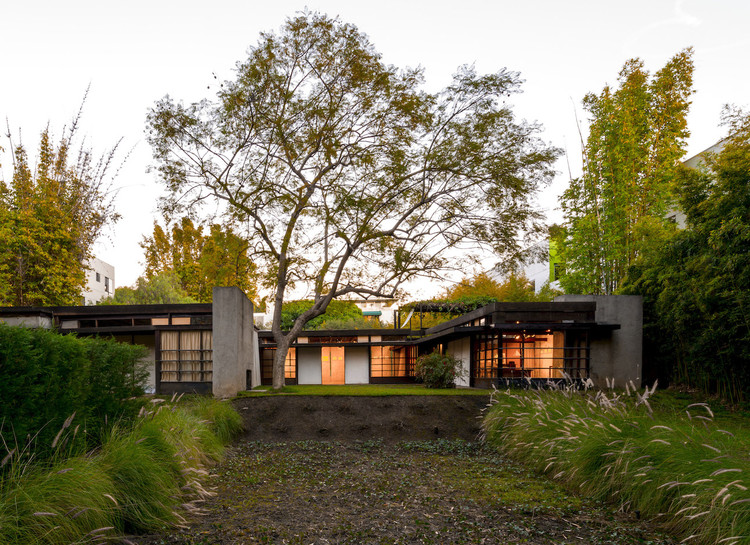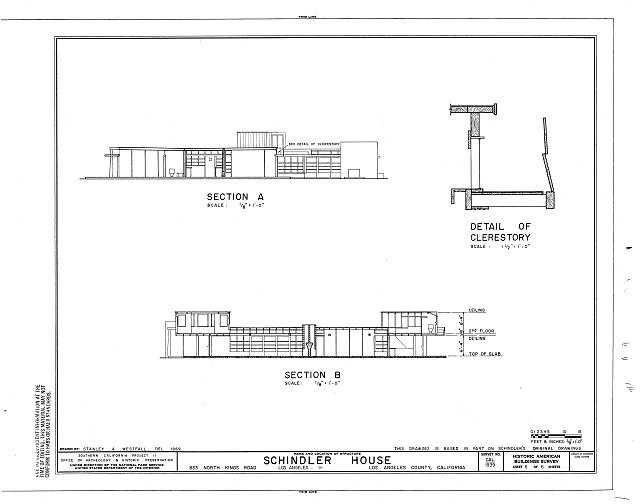
Secluded behind a screen of tall bamboo shoots in West Hollywood, Los Angeles, the Kings Road House may be considered the first home ever built in the Modernist style.[1] Designed by Rudolf Schindler in 1921, the architect’s use of tilt-slab concrete construction (highly innovative at the time) and an informal studio layout, set it apart from its contemporaries; indeed, the design would set the tone for other Modernist residential design for decades.
During his architectural studies in his hometown of Vienna, Austria, Rudolf Schindler became intent on traveling to the United States to work with Frank Lloyd Wright. He sailed to New York only five months before the outbreak of the First World War; by the war’s end in 1918, he had achieved his goal and joined Wright’s practice. In 1919, Schindler married Sophie Pauline Gibling, a music teacher and political activist from Minneapolis who shared his distaste for traditional institutions – including marriage itself.[2]
Wright invited the newlyweds to his Taliesin studio in Wisconsin in July 1920. The experience had a significant impact on both Rudolf and Sophie–the manner in which the house and its rural surroundings coexisted in harmony appealed to them, and they began to dream of building a new studio home for themselves.[3]


The opportunity for Schindler to build his dream house arose when he and his wife moved to Los Angeles later that year. It was there that Schindler developed an acquaintanceship with the architect Irving Gill, who, in Schindler’s opinion, was the only local designer attempting to break away from the Spanish Colonial revival popular in Los Angeles in the early 1920s. Schindler was particularly fascinated by Gill’s work in tilt-slab construction, in which concrete walls were poured into molds and tilted into place on site after curing. The pastoral serenity of Wright’s Taliesin and the industrial efficiency of Gill’s tilt-slab concrete would ultimately come together in the designs Schindler began drawing up in November 1921.[4]

The house was conceived not as a single-family residence, but as one to be shared with Marian and Clyde Chace. Schindler would serve as the architect for the project, while Chace acted as the builder. The partnership would therefore save the two couples money on both the labor and material costs of the project.[5] Further economy would be achieved by siting the house on a 200 square foot (18.6 square meter) lot on Kings Road in what was then unincorporated land between Beverly Hills and Hollywood. The planning phase lasted only two months, from November to December of 1921. The final scheme emerged after four design iterations, the last of which was updated to account for the impending birth of the Chace’s first child.[6]

Schindler’s scheme for the Kings Road House was a mixture of individual studios and communal living spaces. He characterized the design as a “cooperative dwelling for two young couples:” a private studio for each adult inhabitant, an entrance hall, an enclosed patio and a bathroom for each couple, two open terraces on the roof for sleeping, a single communal kitchen, and a guest apartment comprised the spaces within the house. The three-bladed pinwheel plan of the building also created several distinct garden spaces at both ends of the lot, carrying the private atmosphere of the interior into the gardens.[7]

The Schindlers and Chaces broke ground on their new home on February 15, 1922.[8] All four future residents took part in the construction process, which centered on Schindler’s improvements on Gill’s tilt-slab system. Whereas Gill had prefabricated entire walls, Schindler used a system of four-foot long (1.2 meter) units, theoretically allowing them to be tilted into position by two men without the use of a crane. The seam between each slab was expressed in glass, breaking the monotony of the unfinished concrete and admitting light into the house.[9]

The roof was supported by a comparatively traditional post-and-beam system. In the studios, one end of each redwood beam was supported by the concrete wall slabs; the other end was supported by two wooden posts. Nonstructural lumber, along with glass and canvas, was also used to create interior partitions and patio doorways. The resulting effect was that of heavy opacity and remarkable openness on opposite sides of each studio, with the garden foliage visible from almost every room in the house.[10]

Construction proceeded quickly, with the house essentially completed by June 1922.[11] For two years, the Schindlers and the Chaces continued to develop their new home by installing new fixtures and purchasing furniture, neither of which they had a budget for after the initial construction of the house. Unfortunately, financial pressures continued to put strain on both couples, and after having a second child, the Chaces had to leave for Florida in July 1924. Less than a year later, Richard Neutra moved into the house along with his wife and son. Schindler’s marriage had already begun to erode before the departure of the Chaces, and while his new professional partnership with Neutra stimulated his burgeoning architectural career, his relationship with his wife only continued to decline. By 1927, Pauline split with her husband and moved out; the Neutras moved out in 1930, and though Schindler continued to lecture alongside Neutra, their relationship grew noticeably colder.[12]

Toward the end of the 1930s, Pauline returned to the house that she and her ex-husband had built. Schindler lived in the studios originally built for the two of them, while Pauline took up residence in the apartments formerly inhabited by the Chaces and the Neutras. The two shared the home as a divorced couple until Schindler’s death in 1953. In 1974, Pauline created a nonprofit organization, the Friends of the Schindler House, to help ensure the house’s preservation. The organization acquired the house in 1980 and began a program to restore the house based on its original completion in 1922. In 1994, a partnership with with the MAK/Austrian Museum of Applied Arts turned the Kings Road House into the MAK Center for Art and Architecture, Los Angeles – a public exhibition gallery in what is now considered West Hollywood.[13]

The world has changed around the Kings Road House. What was formerly open flat land has been completely infilled; indeed, the house is now dwarfed to either side by multi-level apartment buildings. Despite this, the vision shared by Schindler and his wife in 1920 still prevails: hidden behind its neighbors and its verdant curtain wall, the house continues to seamlessly merge indoors and outdoors into one calm, harmonious space.
References
[1] Smith, Kathryn. Schindler House. New York: Harry N. Abrams, Inc., 2001. p7.
[2] Smith, p7-14.
[3] Smith, p16.
[4] Smith, p17-18.
[5] Smith, p18.
[6] Sweeney, Robert and Judith Sheine. Schindler, Kings Road, and Southern California Modernism. Berkeley and Los Angeles: University of California Press, 2012. p14-15.
[7] Sweeney and Sheine, p15.
[8] Smith, p24-28.
[9] Sweeney and Sheine, p18.
[10] Sweeney and Sheine, p20.
[11] MAK Center. “Schindler House.” Accessed February 9, 2016. http://makcenter.org/sites/schindler-house/.
[12] Smith, p26.
[13] “Schindler House.”
- Area: 3500 ft²
- Year: 1922
-
Photographs:Joshua White Photography















